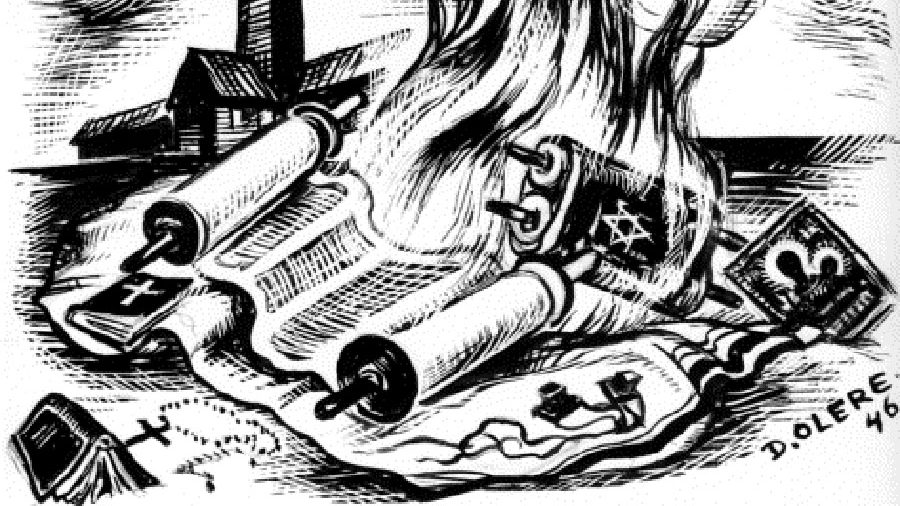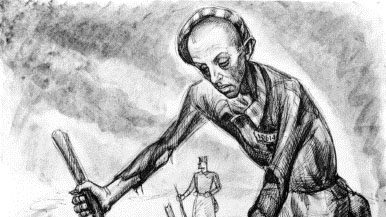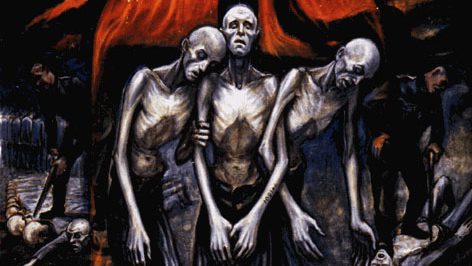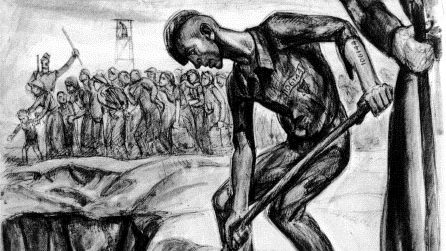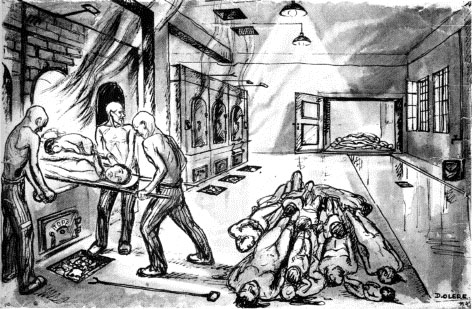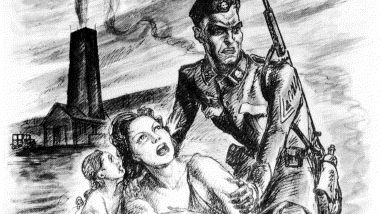Educator Tools

 Ask yourself:
Ask yourself:
- What can Olère’s pencil sketches and colour paintings teach us about every day events in the concentration camps during the Holocaust?
- How do his painful sketches and drawings call us to witness the inhumanity of the Nazi regime?
Olère bore testimony as the only witness present in the haunting documentary sketches and paintings. A recent book, Witness: Images of Auschwitz, combines Olère’s artwork with texts by his son, Alexandre Oler. Olère’s work is one of the most important representations of the atrocities of the Holocaust.
Art as testimony
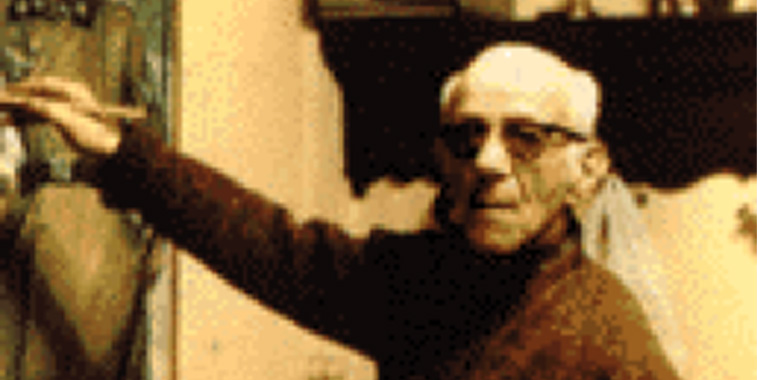
David Olère offers a personal testimony of the atrocity of the Holocaust. His painful sketches and drawings call us in witness to the inhumanity etched in our minds through the images of the crematoriums. Olère bore his testimony as the only witness present in the haunting documentary sketches and paintings. You and I, as contemporary witnesses, face ourselves and others while bearing the pain of the burden of history. For further information on David Olère, see The Eyes of a Witness, published by The Beate Klarsfeld Foundation in Paris in 1989. The book contains a three-page summary of David Olère’s life and one hundred pages of his artwork. All of the text appears in both English and French. Olère’s pencil sketches and colour paintings capture the everyday events in the concentration camps during the Holocaust. There are also portraits of some of the Nazi soldiers and layouts of the crematoriums. A more recent book, Witness: Images of Auschwitz, combines Olère’s artwork with texts by his son, Alexandre Oler. Olère’s artistry is truly one of the most important representations of the atrocities of the Holocaust.
 Artifacts
Artifacts
Artifact 1 › Destruction of the Jewish People / Destruction du peuple juif
1946, 29×20 cm, Ghetto Fighters House, Israel.
Source: David Olère Drawings & Paintings
The fire consumes Torahs, phylacteries, and a tallis, as well as various Christian religious articles.
Artifact 2 › David Olère Burying the Remains of Children / David Olère enfouissant des restes d’enfants
32×40 cm, Olère Family.
Source: David Olère Drawings & Paintings
Olère’s first assignment at Auschwitz was as a grave digger of bunker 2. His prisoner number, 106144, is seen both on his shirt and as a tattoo on his left arm. That number appears in many of Olère’s artworks, sometimes forming a part of his signature.
Artifact 3 › Their Last Steps / Leurs derniers pas
1946, 73×54 cm, Ghetto Fighters House, Israel.
Source: David Olère Drawings & Paintings
Three Muselmänner support each other as they falter toward the gas chamber. Muselmann was the camp term for those whose physical and mental exhaustion made them candidates for “selection.”
Artifact 4 › My First Dialogue / Mon premier dialogue
1949, 36×38 cm, Olère Family.
Source: David Olère Drawings & Paintings
Subtitle: “They also are responsible for the war?” “Yes, that’s war.”
Artifact 5 › The Oven Room / La salle des fours
1945, 58×38 cm, Ghetto Fighters House, Israel.
Source: David Olère Drawings & Paintings
A freight elevator in the background brought bodies up from the basement-gassing chamber of crematorium III at Birkenau. The wet trough at the right facilitated the dragging of bodies to the ovens.
Artifact 6 › Selection for Gas Chambers / Sélection pour le gaz
1947, 41×51 cm, Ghetto Fighters House, Israel.
Source: David Olère Drawings & Paintings
Credits: David Olère: L’Oeil du Témoin/The Eyes of a Witness. New York: The Beate Klarsfeld Foundation, 1989 David Olère Drawings & Paintings
ACTION 1
Do
Reading the Image
Pick one or two of David Olère’s works. Look for photographs of the Holocaust that you think are similar to the artwork. Answer these questions for the photos and the artwork:
- Which piece has more of an impact?
- What kind of an impact does it have? Why?
- What do you think is the difference between the photographer’s point of view and Olère’s?
- Do both pictures have a theme?
- How successfully does each artist carry out the theme?
- What is the central focus of each?
- What kind of details add to the understanding/ appreciation of what the photographer and the artist are trying to convey?
- What similarities and differences do you see between the photo and the artwork?
ACTION 2
Do
Selecting a caption
Using readings from class (Primo Levi, Elie Wiesel, and other diaries & memoirs) find quotes from your readings that you could use as captions for some of Olère’s work.
ACTION 3
Do
Narrowing my focus
Block off parts of one of the artworks. What details would you zoom in on and why? How does looking at the details change your view of the picture as a whole?
ACTION 4
Do
Comparing depth
Compare the foreground, middle ground, and background of a piece. What kinds of sequencing and transitions did Olère use? What point was he making by such placement?
ACTION 5
Do
Olère
View the artworks by Olère in the image gallery to answer the following questions.
A. Consider the drawing “Their Last Steps.”
- What grim building dominates the landscape?
- Does the shape of that building form a symbol that you might not expect a Jewish artist to include in a painting? What is it? Can you find examples of other twentieth century Jewish artists who have used this symbol to represent the suffering of the Jewish people?
- What adjectives describe the physical condition of these men?
- How has the artist suggested their loyalty to one another?
B. In “Admission in Mauthausen” there is a strong contrast in the way Olère depicted the prisoners and their captors.
- List several ways in which this particular picture emphasizes that contrast. Consider the way the figures are grouped. Consider the men’s posture.
- Does it change your feelings about the image when you learn that this is a roll call in the wintertime?
C. Study David Olère’s “Burying the Remains of Children.” One of the most painful jobs assigned to Olère at Auschwitz must have been the burial of murdered children.
- Compare the figure of Olère in the foreground with that of the SS guard in the background. How do you think each man feels about the job he has been assigned to do?
- The artist has placed the Nazi at the center of the painting, but his own self-portrait tends to hold our attention. Perhaps this is because of the gesture that he is making with his left hand. What kinds of emotions does an outstretched hand express?
- Notice the unburied hand to the left of the shovel. It is a realistic detail, of course, but it may also be seen as a symbol. Like Olère’s hand, it is outstretched; it reaches upward even in death. What sort of thoughts do you have as you consider this lifeless hand?
D. In the woodcut, “Destruction of the Jewish People,” Olère presents us with a literal image of the destruction by fire which gives meaning to the term “Holocaust.”
- Distinguish the two kinds of burning that are illustrated here.
- What sort of variety is there among the objects that are being consumed in the foreground?
Resources
- The Complete Maus: A Survivor’s Tale. An excellent resource for a high school art class.
- Degenerate Art. PBS Home Video, 1993. 60 minutes. “Degenerate Art” examines the historical context of the infamous Entartete Kunst (degenerate art) exhibition mounted by the Nazis in Munich in 1937 and the far reaching effects of the Nazis’ vilification of the avant-garde in Germany. The film includes archival footage of the Nazi book burnings, installation shots of the original Entartete Kunst exhibition, and interviews with historians, art critics, family members of several defamed artists, and eyewitnesses to the 1937 exhibition which lend a poignancy and immediacy to this powerful story of the Nazis’ attack on modern culture.
- Olympia. Leni Riefenstahl’s two-part documentary record of the 1936 Berlin Olympics. Part one: Festival of the Nation includes the Olympic ceremonies and events. Part two: Festival of Beauty features the grace and beauty of athletes in motion.
- Triumph of the Will. Leni Riefenstahl’s powerful propaganda film.
What does Six Million Look Like?
In 1998, a group of eighth graders in Whitwell, Tennessee set out to collect six million paper clips. The goal of the project was to help the young people of this rural town understand what diversity means. By examining what happened to the Jewish people, the educators hoped to demonstrate to these students what intolerance can produce in society. The Holocaust memorial created by the mostly white and Protestant students, is a World War II-era German railcar, welded to a small piece of railroad track in front of Whitwell Middle School. On display are millions of paper clips, each one honouring a victim of hatred and murder by the Nazis. The project is celebrated in a documentary entitled Six Million Paper Clips: The Making of a Children’s Holocaust Memorial.
In 2014, a 1,250-page book was published that consists of only one word. In the book: And Every Single One Was Someone, the word “Jew” appears in tiny type, printed six million times. The author, Phil Chernofsky, a former teacher, claims, “That’s how the Nazis viewed their victims, these are not people, they are just a mass we have to exterminate.” By arranging the words side by side, line upon line helps us contemplate the humanity, the commonality, the diversity and the humanity of each Jewish person who was exterminated. Point to any one of the words and you might wonder: Who was this person? Where did that person live and work? Who did that person love?
Though no names appear in Chernofsky’s book, there has been a strong effort to uncover and document the names of the victims. As pointed out in a New York Times article about the book, the Holocaust Memorial and Museum, Yad Vashem in Jerusalem, has (to date) collected the names of 4.3 million Jewish victims. These identities are memorialized in a Memorial entitled “Book of Names” at Auschwitz-Birkenau.
Memorials such as Book of Names, Six Million Paper Clips, and And Every Single One was Someone, serve as examples that give a realitistic perspective to the unbelievable numbers of those who died in the Holocaust.
Source: New York Times
ACTION 6
Think
Considering Jewish literature
- Some consider Chernofsky’s book a gimmick. Do you think a 1,250-page book with only the word Jew serves a purpose as a memorial to Holocaust victims?
- If you had a copy of And Every Single One Was Someone in front of you, how might you react? What might you wonder about? How would you represent 6 million?
- According to Avner Shalev, the director of Yad Vashem in Jerusalem, over 6000 books are published each year about the Holocaust. Why do you think there are still so many publications released? How does literature—and other art forms—help future generations understand what happened?
ACTION 7
Think
Memorializing as an act of honour
- What project might you consider undertaking to help document the number 6,000,000?
- Imagine that Chernofsky provided an appendix to his book that offers a biography of each of the six million Jews he honours. Is it possible to create a six million-page document? Investigating the life of one of the six million Jewish victims might help you to pay tribute and memorialize his or her identity.
Every effort has been made to gain permission from copyright holders to reproduce borrowed material. The publishers apologize for any errors and will be pleased to rectify them in subsequent reprints and website programming.
Educator Tools


